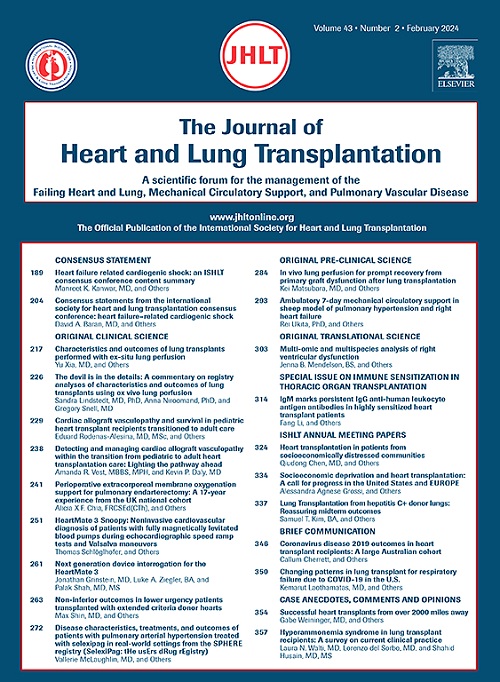严重冠状动脉异体移植物血管病变中心脏异体移植物生理学受限的结果。
IF 6.4
1区 医学
Q1 CARDIAC & CARDIOVASCULAR SYSTEMS
引用次数: 0
摘要
背景:心脏移植后的微血管功能障碍会导致心脏同种异体移植生理功能受限(RCP),这被归类为严重的冠状动脉同种异体移植血管病变(CAV);然而,RCP的预后仍不明确。因此,在本研究中,我们旨在阐明 RCP 与重度血管病变 CAV 的预后对比:我们对 2004 年至 2023 年期间接受心脏移植的 116 例重度 CAV 患者进行了评估。RCP被定义为有症状的心力衰竭,并伴有限制性血液动力学值(平均右心房压>12 mmHg,肺毛细血管楔压>25 mmHg,心脏指数为2)。主要结果是死亡或再次移植:结果:在116名重度CAV患者中,42人有RCP(RCP-CAV组),74人有重度血管造影CAV但无RCP(Angio-CAV组)。RCP-CAV组从心脏移植到确诊的时间明显短于Angio-CAV组,确诊后经皮导管介入治疗的次数也明显少于Angio-CAV组(均为p结论:RCP患者的预后明显差于严重血管造影CAV患者。及早发现微血管功能障碍并再次移植可改善RCP患者的预后。本文章由计算机程序翻译,如有差异,请以英文原文为准。
The outcome of restrictive cardiac allograft physiology in severe coronary allograft vasculopathy
Background
Microvascular dysfunction after heart transplantation leads to restrictive cardiac allograft physiology (RCP), which is classified as severe coronary allograft vasculopathy (CAV); however, the prognosis of RCP remains unclear. Therefore, in this study, we aimed to elucidate the prognosis of RCP in comparison with that of severe angiographic CAV.
Methods
We assessed 116 patients with severe CAV who underwent heart transplantation between 2004 and 2023. RCP was defined as symptomatic heart failure with restrictive hemodynamic values (mean right atrial pressure >12 mm Hg, pulmonary capillary wedge pressure >25 mm Hg, and cardiac index <2.0 liter/min/m2). The primary outcome was death or retransplantation.
Results
Of the 116 patients with severe CAV, 42 had RCP (RCP-CAV group) and 74 had severe angiographic CAV without RCP (Angio-CAV group). A significantly shorter time from heart transplantation to diagnosis and lower subsequent percutaneous catheter intervention after diagnosis were seen in the RCP-CAV group than in the Angio-CAV group (both p < 0.001). Freedom from death or retransplantation at 5 years was significantly worse in the RCP-CAV group compared to the Angio-CAV group (18.4% vs 35.4%, p = 0.001). In the Cox proportional hazard model, RCP was independently associated with an increased risk of death or retransplantation (hazard ratio 2.08, 95% confidence intervals 1.26-3.44, p = 0.004).
Conclusions
The prognosis of patients with RCP was significantly worse than that of patients with severe angiographic CAV. The early detection of microvascular dysfunction and retransplantation listing may improve the prognosis of patients with RCP.
求助全文
通过发布文献求助,成功后即可免费获取论文全文。
去求助
来源期刊
CiteScore
10.10
自引率
6.70%
发文量
1667
审稿时长
69 days
期刊介绍:
The Journal of Heart and Lung Transplantation, the official publication of the International Society for Heart and Lung Transplantation, brings readers essential scholarly and timely information in the field of cardio-pulmonary transplantation, mechanical and biological support of the failing heart, advanced lung disease (including pulmonary vascular disease) and cell replacement therapy. Importantly, the journal also serves as a medium of communication of pre-clinical sciences in all these rapidly expanding areas.

 求助内容:
求助内容: 应助结果提醒方式:
应助结果提醒方式:


